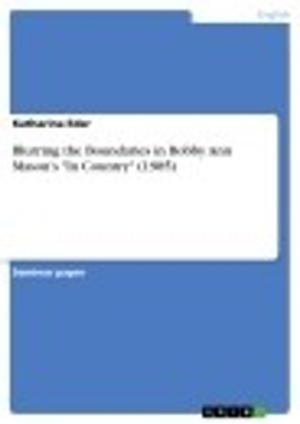The Presence and Influence of Concord, Massachusetts in Transcendentalist Writings
And the Ties That Bound Such Writers
Fiction & Literature, Literary Theory & Criticism, British| Author: | Ashley Levinstone | ISBN: | 9783656866947 |
| Publisher: | GRIN Publishing | Publication: | December 23, 2014 |
| Imprint: | GRIN Publishing | Language: | English |
| Author: | Ashley Levinstone |
| ISBN: | 9783656866947 |
| Publisher: | GRIN Publishing |
| Publication: | December 23, 2014 |
| Imprint: | GRIN Publishing |
| Language: | English |
Seminar paper from the year 2012 in the subject English Language and Literature Studies - Literature, grade: A, University of Abertay Dundee, language: English, abstract: In the mid-nineteenth century, shortly following the loss of his young wife to tuberculosis, and having abruptly abandoned his pastoral position at Boston's Second Church, a 31-year-old Ralph Waldo Emerson moved to the small town of Concord, Massachusetts, to live in the house his father had built, which would later be known as 'The Old Manse.' Here, he and his widowed mother made a home with his step-grandfather, Dr. Ezra Ripley, for a short year, until he managed to purchase his own home, what he called the 'Coolidge Castle,' now known simply as the 'Ralph Waldo Emerson House,' located on the Cambridge and Concord Turnpike. The town of Concord lay seventeen miles west of the city of Boston, adorned in a landscape chock full of beautiful and picturesque ponds, rivers, rolling hills and cliffs, and forests-full of white pines. An already well-established market town with a rich and proud cultural history, Concord's impeccable farmland and utter simplistic beauty seemed to attract and anchor Emerson, who, albeit not a true native, nonetheless quickly managed to establish himself as one of the town's most prominent citizens. In addition to the town's simplicity that he so-often relished in, Emerson also had the added benefit of having just about every one of his family members within an approximate thirty-five mile radius surrounding Concord, the central hub of Emerson family history.
Seminar paper from the year 2012 in the subject English Language and Literature Studies - Literature, grade: A, University of Abertay Dundee, language: English, abstract: In the mid-nineteenth century, shortly following the loss of his young wife to tuberculosis, and having abruptly abandoned his pastoral position at Boston's Second Church, a 31-year-old Ralph Waldo Emerson moved to the small town of Concord, Massachusetts, to live in the house his father had built, which would later be known as 'The Old Manse.' Here, he and his widowed mother made a home with his step-grandfather, Dr. Ezra Ripley, for a short year, until he managed to purchase his own home, what he called the 'Coolidge Castle,' now known simply as the 'Ralph Waldo Emerson House,' located on the Cambridge and Concord Turnpike. The town of Concord lay seventeen miles west of the city of Boston, adorned in a landscape chock full of beautiful and picturesque ponds, rivers, rolling hills and cliffs, and forests-full of white pines. An already well-established market town with a rich and proud cultural history, Concord's impeccable farmland and utter simplistic beauty seemed to attract and anchor Emerson, who, albeit not a true native, nonetheless quickly managed to establish himself as one of the town's most prominent citizens. In addition to the town's simplicity that he so-often relished in, Emerson also had the added benefit of having just about every one of his family members within an approximate thirty-five mile radius surrounding Concord, the central hub of Emerson family history.















